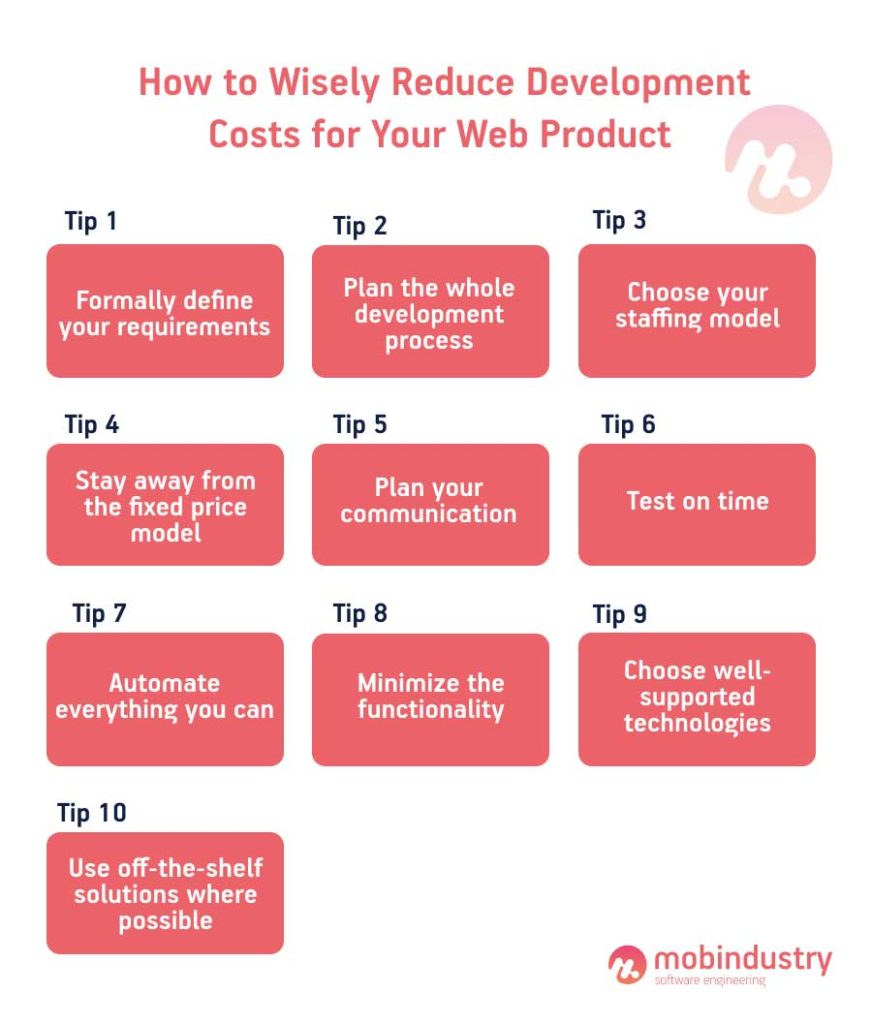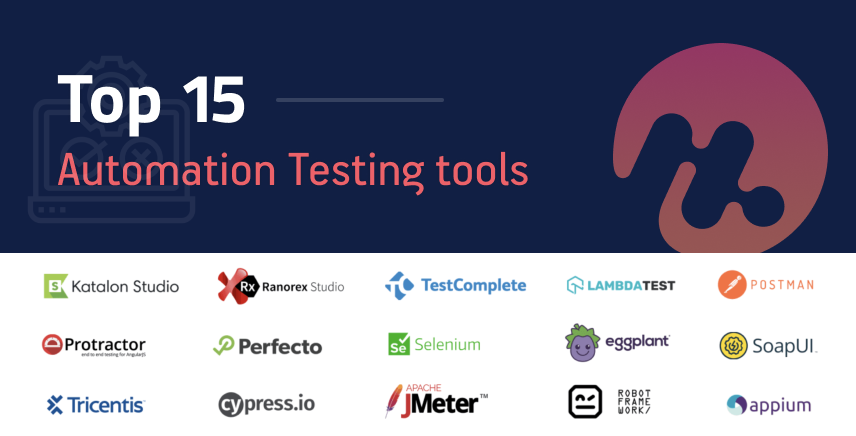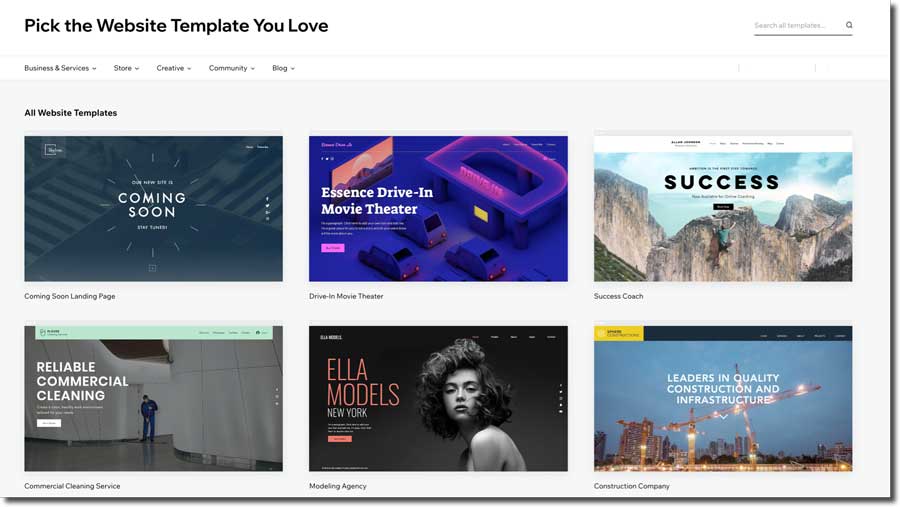Month: February 2022
How to Wisely Reduce Development Costs for Your Web Product
The cost of web development consists of lots of different factors including:
- Your project and its size
- Number and complexity of features
- Chosen technologies
- Cost of third-party services
- Design complexity and animations
- Team size
- Deadlines
- Team experience and expertise
- Team’s hourly rate
All of these factors will influence the final cost of your web project, but is there actually a final cost? Expenses for software don’t end with deployment, and businesses on average spend 10% to 50% of their annual software development budget on maintenance and support.

Building software for your organization is a long-term commitment, and the better you optimize your initial web development process, the less it will cost you in the long term. In this article, you’ll learn about the factors that influence the website development cost and find out how to make sure your development and support costs don’t grow exponentially over the years.
Tip 1: Formally define your requirements
At the very beginning of software development, businesses often have a vision of what product they would like to have, how it would help their business, and what features they’d like to see.
However, sometimes business owners skip the planning and documentation phase, which can lead to more expenses in the future.
It’s extremely important to document your requirements and plan the development process before it starts. Moreover, it’s vital to keep documentation up to date. How can you determine your requirements?
At Mobindustry, we call the process of determining your requirements the discovery phase. Before development starts, we gather all information about the project and how it will be connected to your business processes. The discovery phase includes learning about your:
- Competitors
- Market conditions
- Product vision
- Target audience
- Business goals
- Deadlines
The business analyst extracts all business requirements from the client and creates a detailed technical specification based on your needs. This specification includes everything from your product’s functionality and business logic to third-party services and people responsible for delivery.
Tip 2: Plan the whole development process
Now that you have a technical specification and all your team members are on the same page, it’s time to plan the development process. According to Agile development best practices, the whole process should be divided into sprints. While sprints are flexible and can be changed according to the current business needs or urgent requirements, they should still be a blueprint for the whole development process.
Consult your development team when planning development. Some projects are more productive with one- or two-week sprints, while others require more time for each sprint. Your development team should take your business goals, budget, and deadlines into account when planning the project and its timeline.
The planning process should involve lots of prioritization. When you have a clear plan, you’ll be able to choose the most important features to develop first and formulate an MVP that you’ll be able to release before the whole project is done.
A roadmap and a technical specification are the two main tools for planning software development, so make sure to spend time on both these documents. At first this may seem counterproductive, as you spend a lot of time on planning instead of going right into development. But this stage will pay off in the long run and help you reduce development time.
Tip 3: Choose your staffing model
There are many ways to organize your development team. Large corporations that have constant needs for programming hire developers in-house. Smaller organizations and startups prefer to outsource development and have shorter-term plans.
Non-tech companies usually need particular products like websites or apps to communicate with and provide service to their customers, so they tend to partner with outsourcing companies or hire freelancers.
Your staffing model will also determine the final cost of your web product development. In most cases, hiring developers in-house will be more expensive than outsourcing development. There are several reasons for this:
- Hiring in-house developers means paying for recruiting, workspaces, equipment, taxes, bonuses, salaries, sick leaves, vacations, and so on.
- Hiring in-house developers limits your pool of specialists to those who are local, which means you need to offer salaries and conditions that are competitive in your country or region.
Also, hiring only developers isn’t enough for most modern software development projects. You also need business analysts, project managers, quality assurance specialists, and designers for a high-quality product. Hiring all these specialists in-house or trying to organize a team of freelancers will be extremely expensive, and managing them will be hard.
By outsourcing your product development, you can save money due to these factors:
- Your outsourcing partner may be located in a country with a cheaper cost of living, so the hourly rate will be lower than that of your local developers.
- You’ll pay only for the time spent on your project, without having to worry about taxes, salaries, workspaces, and so on.
- You’ll get a whole team available immediately without having to spend both time and money on recruitment.
Tip 4: Stay away from the fixed price model
The unpredictability of software development costs holds many people back from creating websites and apps that will boost their business. The fixed price model adds certainty and helps you predict the budget, but in most cases it’s only an illusion.
A fixed-price model seems very attractive to clients at first. It’s more predictable, and clients like to know exactly how much their project will cost. However, they often pay more than they could if they chose the Time and Material model, because vendors try to protect themselves and count all the potential risks into a Fixed price estimate.
Yulia Kutsokon, project manager at Mobindustry
First, when a company prepares a detailed estimate for your fixed price project, they count in absolutely all possible risks to protect themselves from unpredictable situations. This means the initial estimate will be higher than it would be if you worked according to the time and materials model.
Second, you won’t be able to predict everything on the project, including your own business needs, which can change with the market conditions, as new players enter the market, and based on trends and requests from your customers. In my experience, projects are rarely developed according to a strict plan, which is why the whole IT world has shifted to the Agile development and planning methodology.
A fixed price model will lead to you paying double what you could have paid while also getting a product that may not be relevant by the time it’s finished, meaning you’ll need to pay to redo it.
Tip 5: Plan your communication
Communication during web project development can make or break your project’s success. While everyone on the team should be on the same page, overdoing communication can lead to low motivation and tons of wasted time.
Your communication with the team should be planned just like everything else on the project. For cost-effective web development, determine how often you expect to communicate with your team and by what means.
Each communication tool should have its purpose. For example, keep email for reporting and invoicing, discuss current plans and issues on daily meetings or calls, and so on.
A lack of structure in communication can lead to frequent changes of direction, misleading requests, and management inconsistencies that will harm the development process and mess with the schedule. Make sure that communications involve the right people and achieve certain goals.
Tip 6: Test on time
According to cost-effective software development best practices, testing should happen almost simultaneously with development. Putting off testing till the end of the project will result in lots of additional costs, because just as with taking care of your health, it’s cheaper to prevent an issue than to treat it.
Testing on web development projects should happen according to the continuous integration practice. This means that each time a developer completes a certain part of the project code, they run this small part through tests and only then merge it with the rest of the codebase.
This allows developers to significantly reduce the time and cost of testing, development, and deployment.
I highly recommend involving a quality assurance team on every project. Some clients prefer to handle testing themselves, but this often results in reworking parts of the code and losing even more time and money on fixing something that could have easily been dealt with from the start.
Also, pay attention to what types of tests you do from the beginning. Usually, product owners and developers are focused on functional and security testing, and some types of testing are put aside till the end of development. User acceptance testing (UAT) is one of them.
I recommend you start UAT early because fixing your product once it’s live and not being accepted by the users is painful and can lead to reputational damage and wasted money.
Tip 7: Automate everything you can
Automating testing and deployment can seem counterintuitive, because you need to spend time to create automated tests and set up the automation software for your project. It may seem that testing everything manually is less expensive, but in the long run test automation will not only save you lots of time and money but also increase your product’s quality.

How does it work? In regards to testing, quality assurance specialists spend lots of time manually checking each part of the software, and these tasks are often very repetitive. Instead, they can use automated testing for trivial tasks and spend more time dealing with bugs and inconsistencies that aren’t so obvious.
Tip 8: Minimize the functionality
The market conditions for most software products today require high quality and something extra that makes the product better than the competition. However, it’s easy for businesses to go into an endless loop of improvements and a desire to create the best product possible.
Unfortunately, having an outstanding product doesn’t cut it for most businesses. Time to market, marketing strategy, flexibility, and the correct target audience are what contribute to the success of a software product, not necessarily the bells and whistles you add to it, especially when your budget is limited.
To reduce software development cost, you should minimize the product’s functionality. A few high-quality features are better than many mediocre features. How can you actually choose the functionality that’s absolutely necessary?
The best way to do it is to create user stories. Each user story is a path a user takes to achieve a goal. For example, if you want to create a parcel delivery web application, your user may enter your platform to prepare documents for sending a parcel, contact support, or check the status of their delivery.
All the functionality you plan to implement should be dedicated to a certain goal. Once you create user stories, you can start working on your MVP and prioritize features.
Tip 9: Work on the team structure
Your team structure should be clear to everyone working on the project. Team members should know what they’re responsible for and to whom they should communicate any issues.
A typical web development team includes:
- A frontend web developer
- A backend developer
- DevOps
- Quality assurance specialist
- Business analyst
- Designer
When you outsource development, a project manager is usually responsible for communication between you and your outsourcing team. The lead developer is responsible for the code delivered, and the head of quality assurance should make sure the software works properly and according to the technical specifications.
In large projects there can also be other roles that regulate communication among all stakeholders, such as a product owner. A product owner acts as a link between the final product and future users. A product owner makes sure that the product helps users solve problems and that the target audience is chosen correctly.
Tip 9: Choose well-supported technologies
The programming landscape changes every year, and newer, better technologies emerge and start to slowly conquer the market. If you want to build an innovative product, it may be tempting to use a shiny new technology that will make you different from other market players.

However, there are perks to using time-proven and popular technologies that may seem boring. Why will making a safe choice help you save money on development?
1. Recruitment. Finding a developer who is an expert in a rare technology is hard. And if you already have such a specialist on the team, it may be problematic to find a replacement if they leave. Even if you outsource development, finding vendors that have specialists in rare languages will be harder and likely won’t save you money.
2. Development speed. Developers rarely create something completely from scratch. Rather, they use customizable libraries and tools. Popular programming languages and frameworks already have everything you can think of in terms of ready solutions, APIs, and so on, and this significantly increases the development speed.
3. Support and community. Popular languages have large communities that constantly add new features to frameworks and solve issues. This means a lot to fresh developers who can find good documentation and guidance, so if you add a specialist with slightly less experience to your project, it will be easy for them to adapt.
Tip 10: Use off-the-shelf solutions where possible
Using off-the-shelf software solutions is usually possible only for typical and simple websites and applications for small and medium-sized businesses. For example, you can use an off-the-shelf solution to build a simple online store or your business.

However, you can also use ready solutions as parts of your software, especially at the beginning. For example, there are lots of ready modules in frameworks. Ask your development team how you can optimize development without causing much technical debt in the future by integrating off-the-shelf modules into your product.
Also, you can accelerate your development significantly by using backend as a service solutions that will help you focus on solving business issues instead of working long months on backend infrastructure.
Final thoughts
In this article you’ve learned how to reduce software development costs. The cost of development depends on lots of factors, but there’s always a possibility to influence the final cost by optimizing the development process, thoroughly planning, efficiently communicating, and focusing on what matters most.
Outsourcing development is one of the best ways to optimize web development costs. Without changing the scope and worrying about hiring, you can immediately cut your development costs threefold depending on the country of your vendor.
If you want to save even more of your budget, you should prioritize features, use ready solutions like BaaS, and make sure you plan the whole development process and do testing simultaneously with development.
At Mobindustry, we create web applications of all sizes and types and always make sure to meet our clients’ requirements and deadlines. If you have any questions on web development at Mobindustry or you’d like to get a quote, feel free to contact us.

